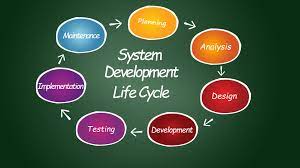The Systems Development Life Cycle (SDLC) is a framework that outlines the phases and activities involved in the development and implementation of software systems. While different organizations and projects may have variations, the typical SDLC consists of the following stages:
- Requirements Gathering: In this initial phase, systems analysts work closely with stakeholders to gather and document system requirements. This involves understanding business processes, user needs, and system objectives. Requirements are identified and documented in a clear and concise manner.
- System Analysis: Systems analysts analyze the gathered requirements to determine the feasibility of the proposed system. They assess technical, economic, and operational factors to evaluate potential solutions. This phase involves creating system models, such as data flow diagrams and use case diagrams, to represent processes, data flows, and interactions.
- System Design: In the design phase, systems analysts collaborate with developers and architects to create a detailed system design. This includes designing system components, database structures, interfaces, and user interfaces. The design phase focuses on transforming the requirements into a blueprint for the system to be developed.
- Development: The development phase involves the actual coding or programming of the software system. Developers write code based on the design specifications created in the previous phase. This phase incorporates best practices, coding standards, and quality assurance measures to ensure the development of a reliable and maintainable software system.
- Testing: Systems analysts and testers work together to ensure the quality and functionality of the developed system. Testing involves executing test cases, validating system behavior, and identifying and fixing defects. It includes various types of testing, such as unit testing, integration testing, system testing, and user acceptance testing.
- Deployment: Once the system has been thoroughly tested and approved, it is deployed or implemented in the production environment. This phase involves planning for the installation, configuration, and integration of the software system within the existing IT infrastructure. Data migration, user training, and system documentation updates may also be part of the deployment activities.
- Maintenance and Support: After the system is deployed, systems analysts may be involved in ongoing maintenance and support. This includes addressing user issues, making system enhancements, and performing regular updates and patches to ensure system stability and security. Maintenance activities can include bug fixes, performance optimization, and feature enhancements based on evolving business needs.
Throughout the SDLC, systems analysts play a critical role in gathering requirements, analyzing and designing systems, coordinating with stakeholders, and ensuring the successful development and implementation of software systems.
SHARE
